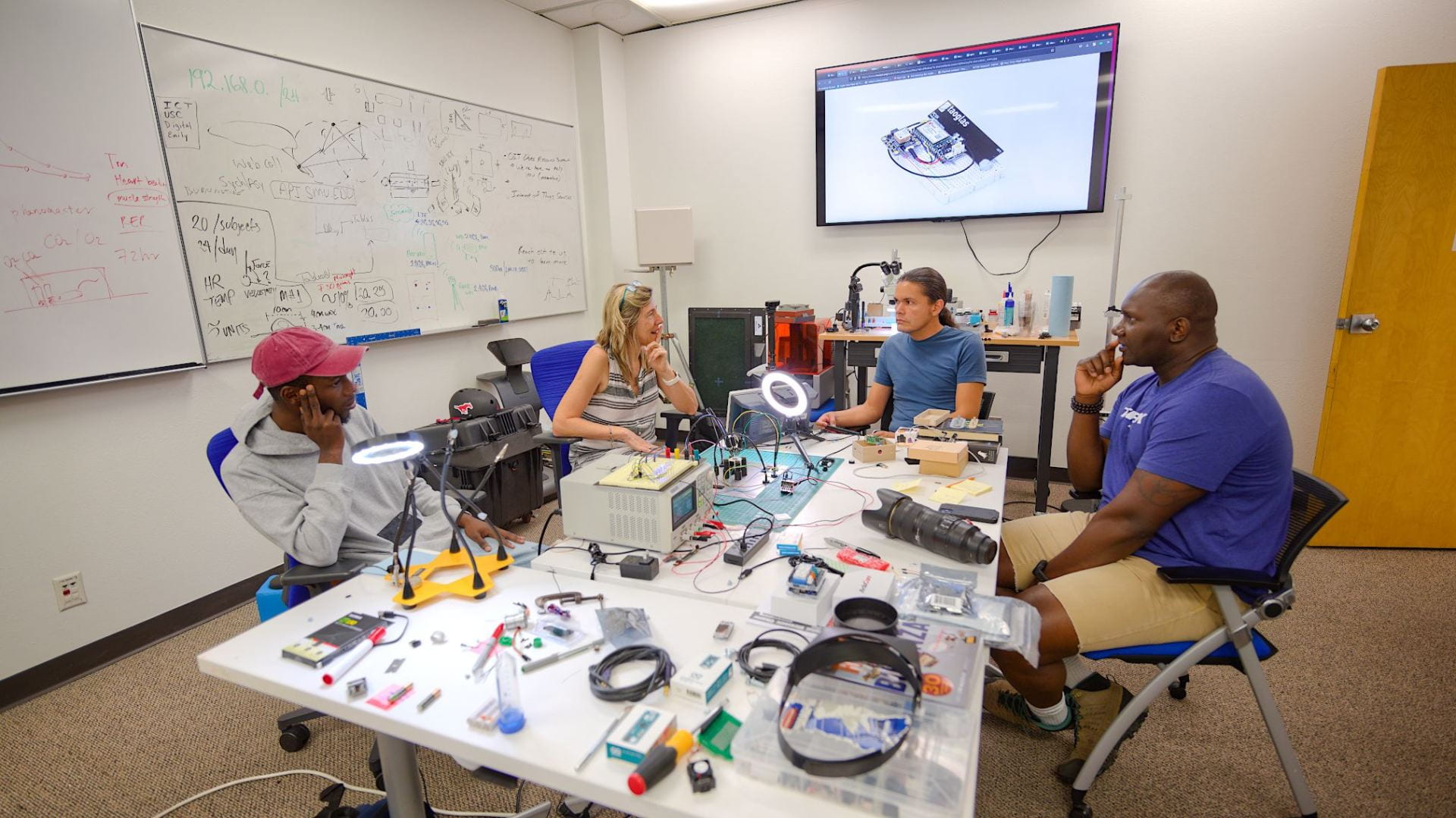Photography and additional reporting by Guillermo Vasquez.
 2023 has proven to be a pivotal year in the evolution of our Research Development and Internet of Things (IoT) services. With new equipment and new relationships forged across campus, Guillermo Vasquez and his IoT Lab have been hard at work to bring data points once thought ephemeral into the realm of data-driven research.
2023 has proven to be a pivotal year in the evolution of our Research Development and Internet of Things (IoT) services. With new equipment and new relationships forged across campus, Guillermo Vasquez and his IoT Lab have been hard at work to bring data points once thought ephemeral into the realm of data-driven research.
From the ballroom to the physics lab, ideas and resources have come together in the IoT Lab to implement the quickly growing Internet of Things ecosystem in all disciplines. A key aspect of this level of service is the deep collaboration Guillermo undertakes with researchers to truly understand their needs and develop solutions that can effectively and efficiently deliver results for world-changing research projects.
Several examples in the past year showcase the exemplary level of service provided by the IoT Lab. The Meadows School of the Arts has several projects that explore the fascinating intersections between the realms of music, dance, theater, and the fields of engineering, technology, AI, and IoT, including advanced sensing equipment to collect data from the physical movement of dancers. Using this information, researchers then developed mathematical models for pairing dance partners, ensuring that both their skills and physical attributes complement each other—creating compelling performances in ways not thought possible and bringing what was once thought ephemeral into the realm of data-driven research. This system also sets the stage for a future Physical Data Capture Lab, which could be utilized to measure the physical movements of a subject to help in the diagnosis of individuals with neurological disorders, such as Parkinson’s, without the need for cumbersome sensors attached to a patient’s body.

Dr. Jill DeTemple, professor and researcher in Dedman College’s Department of Religious Studies, has long championed the advantages of using Reflective Structured Dialogue to enhance classroom discussions and foster a welcoming, engaging learning environment that improves student communication skills and overall outcomes. The Classroom Conversation Visualizer system was developed to measure and visualize these advantages. Using a motion detection system powered by a ball passed around amongst students when speaking, class conversations can be mapped to show how they develop and evolve during class time. Dr. DeTemple reports that she found what she was looking for in her research: “[The Classroom Conversation Visualizer] shows what my research team and I have long thought true. We can make spaces where everyone is empowered to speak, listen, and learn. Thanks to SMU’S Internet of Things team for creating the tech that made this visualization possible.”

In the Physics department, the IoT Lab assisted Dr. Thomas Coan with harnessing the power of small single-board computers (like Raspberry Pi devices) to develop a detection system that enables the detection and counting of muon particles – fundamental building blocks of our universe. This system enhances advanced Physics courses, empowering students and faculty to conduct more comprehensive research and analysis of these particles.
In Lyle, work is underway with Dr Jessie Marshall Zarazaga to tackle the issue of the well-being of women gold miners in Colombia using affordable technologies to enhance their working conditions. Our IoT innovations are going beyond campus and into the field across town to across the world.
With RTK GNSS, miniature flying drones and data collection equipment are being placed inside compact backpack setups to allow for remote collection of geographic data to help map areas of rural Africa to empower local communities, governments, and organizations in making informed decisions, improving land tenure, and supporting economic growth. Guillermo Vasquez shared more about these backpack systems, “By leveraging the power of RTK GNSS and the versatility of drones, we can bridge the information gap and foster sustainable development in these communities.”

The IoT Lab also made strides in community outreach in 2023, presenting a sampling of devices and an interactive “baby supercomputer” at the International Science and Engineering Fair in Dallas, further promoting STEM education and research and SMU’s vast technology resources to aspiring high school scientists!

A new addition this year was a desktop Printed Circuit Board (PCB) printer, which provides the IoT Lab the ability to quickly print circuitry onto many different surfaces, including flexible materials. These flexible boards can then be attached to small research subjects or surfaces. Currently, it is producing minuscule vital sign trackers, essentially a type of fitness tracker like what is found in a Fitbit or Apple watch, to make collecting important data easier for researchers with less physical intervention. Where researchers needed to check vital signs manually once an hour, the same checks are now done remotely and automatically transmitted to a central database. Other possibilities for this printing platform, in tandem with our existing 3D printing capabilities, include faster mockups of conceptual circuitry for an assortment of applications. Conversations with faculty and researchers across campus have brought up opportunities from tracking missing Alzheimer’s and Dementia patients to detecting vital sign changes during classroom conversations.
These examples feature just a fraction of the impact that the Internet of Things Lab is making at SMU and its research initiatives around the world. If you and your research teams have a challenge that needs tackling, we invite you to start the conversation, and we hope you will be pleased with how far it takes you!
Photos: Guillermo Vasquez. Used with permission.



